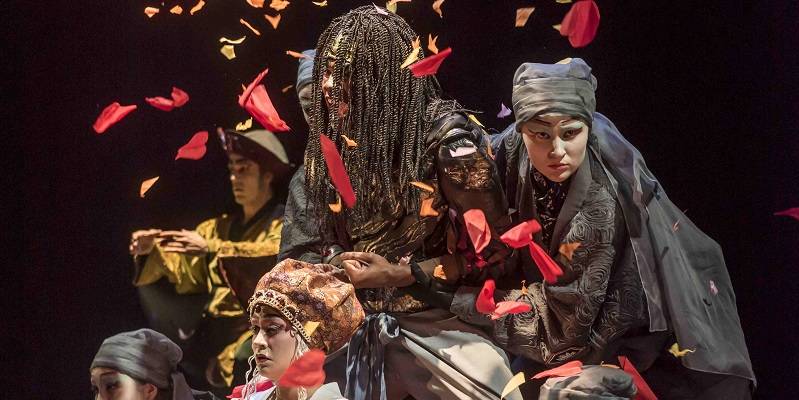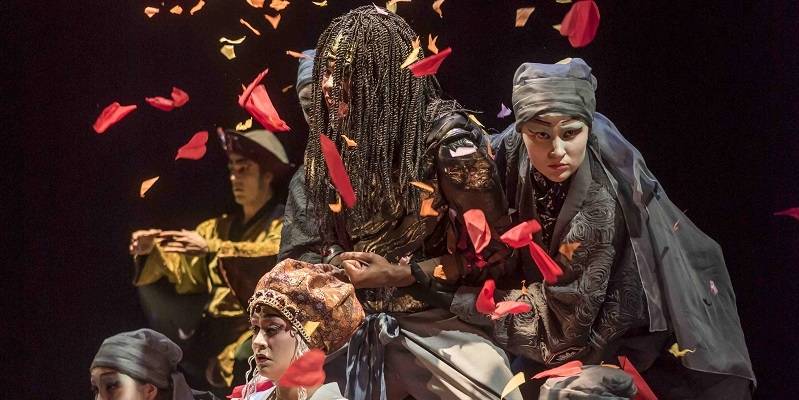
People gush about Shozo Sato and his kabuki adaptations of Western classics, and as a resident of this town you might find your interest piqued – especially if you’ve never seen any formal Eastern theatre. “It will be a different experience,” you might think, “Something I’ve never done before.” You hear about how beautiful it is, how physically demanding, how unlike anything you’ve ever seen. All of these things are true, and the form and execution deserve the praise it garners. But something that no one ever mentions about kabuki – your first one will incur some slight discomfort.
I was lucky enough to see Lady Macbeth: a Kabuki Play, also by Shozo Sato, five years ago when it was at Krannert. I went in blind on purpose, and found a completely foreign experience. Although the actors were speaking English, between the cadence and the poses and the repetition, I spent quite a while trying to grasp for something familiar. Thinking back to that experience, I tried to prepare my boyfriend for Iago’s Plot as best I could. “The delivery is unusual,” I told him, “Kind of sing-song,” I intoned in my best impression of the tones I’d heard in 2012. “The makeup is not just dramatic, but like masks almost, and the costumes are very traditional.” I bombarded him with facts and memories throughout the week; I did everything except send him links to performances on youtube, because at the same time, I didn’t want to spoil it.
For me, with Iago’s Plot, there was no adjustment period. I was ready, and although the tsuke always startle me, as soon as I heard them, I was eager.
Sato’s adaptation did not disappoint – it was a beautiful blending of modern and ancient, Western and Eastern. There was a scrim that displayed a projected animation before the production began, and became the surface for a shadow play pantomimed by Othello and the four Koken. There were dance scenes of English country dancing set to traditional Japanese instruments. The character makeup used elements of traditional kabuki (especially the color schemes to denote character) but was understated rather than using a full mask technique. The lighting was dramatic, starkly accentuating the characters’ poses, and highlighting the costumes.
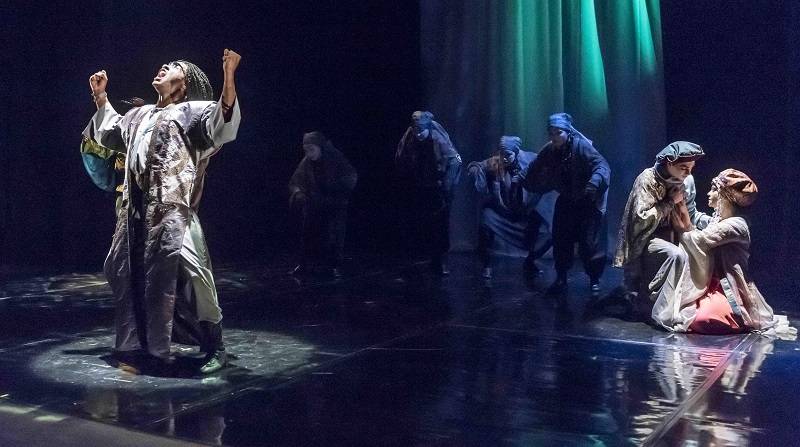
Oh, the costumes. The costumes were an ingenious hybrid of Elizabethan-era European and stylized Eastern wear. I could spend this entire article talking about how Desdemona’s furisode complimented her empire-waist gown, or how from one angle Iago’s hat looked exactly like a kasa, but from another it could have appeared in a Zeffirelli film. Don’t even get me started on Othello’s shogun “armor” that became actual armor. Costume designer Olga Maslova is such a big deal that she doesn’t need my praise – but she has it because not only were they gorgeous but it made perfect visual sense.
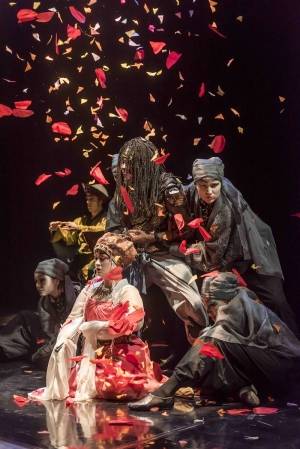 Except for Emilia’s costume, but I am certain this was a directorial choice. Emilia is Iago’s wife and a maidservant to Desdemona, who in Shakespeare’s play is quite close friends with the lady and has several spirited and cheeky speeches. In Sato’s adaptation, it began with Emilia in mourning, wearing black and a veil, and telling the entire story in retrospect, in grief for her dead friend (spoiler for a 400 year old play). However, because of the focus on Iago and his villainy, we never saw the friendship grow between Desdemona and Emilia, and she lost her original speeches in exchange for being the narrator. This made it harder to understand Emilia’s deep grief, because the two women barely spoke to each other onstage. While it was still a good and necessary role, this interpretation flattened both the characters of the women, and removed some of my favorite parts from Othello.
Except for Emilia’s costume, but I am certain this was a directorial choice. Emilia is Iago’s wife and a maidservant to Desdemona, who in Shakespeare’s play is quite close friends with the lady and has several spirited and cheeky speeches. In Sato’s adaptation, it began with Emilia in mourning, wearing black and a veil, and telling the entire story in retrospect, in grief for her dead friend (spoiler for a 400 year old play). However, because of the focus on Iago and his villainy, we never saw the friendship grow between Desdemona and Emilia, and she lost her original speeches in exchange for being the narrator. This made it harder to understand Emilia’s deep grief, because the two women barely spoke to each other onstage. While it was still a good and necessary role, this interpretation flattened both the characters of the women, and removed some of my favorite parts from Othello.
However changed the role of Emilia was, Jessica Kadish faced an enormous challenge to come onstage by herself and deliver the opening monologue in tones highly modified from her normal speech. She lowered her voice to a guttural range and nearly bellowed her grief. It was astounding and impressive, and although it was surprising enough to elicit some titters from the audience, she continued unfazed. I realized from the playbill that I have actually seen every play she has performed with Illinois Theatre, and her range and professionalism are something that I have just come to expect. That in itself says a lot, but she deserves recognition, especially for being the first to draw blood in front of an audience who may not have been entirely prepared for what she handed them.
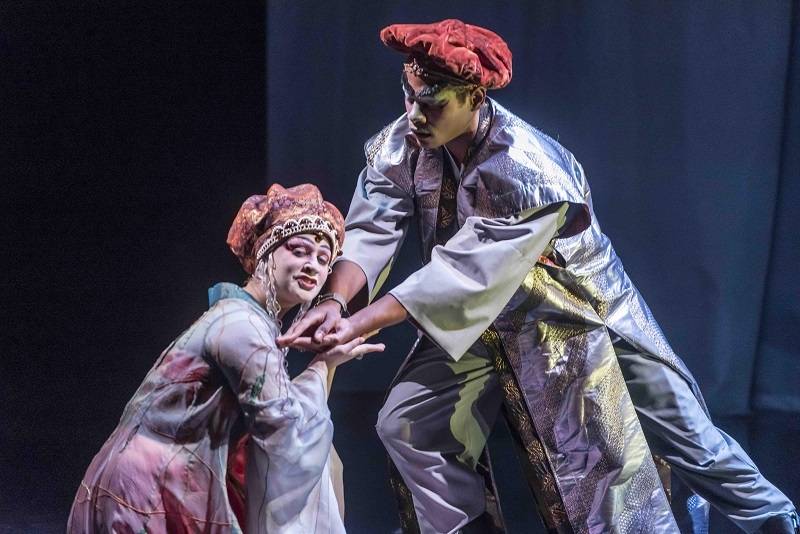
All of the performers were outstanding, fully committed to their performances and all the demands placed upon them. It was clear they all made good use of the two vocal and speech coaches (Susan Schuld and Adam Thatcher) and were physically up to the challenge of holding a character-building pose while fully embodying the role. It is very, very difficult to make pitched speech sound sexy, especially when repeating phrases so many times that they begin to sound like nonsense. But Christian Wilson and Elana Weiner-Kaplow somehow made their Othello and Desdemona demonstrate the intense passion they felt for each other. They also created nuanced and differentiated meanings with each repitition of a phrase, no matter how many times they had to say it. I looked forward to seeing the Koken appear onstage, and Kevin Blair was a charming and naïve Cassio.
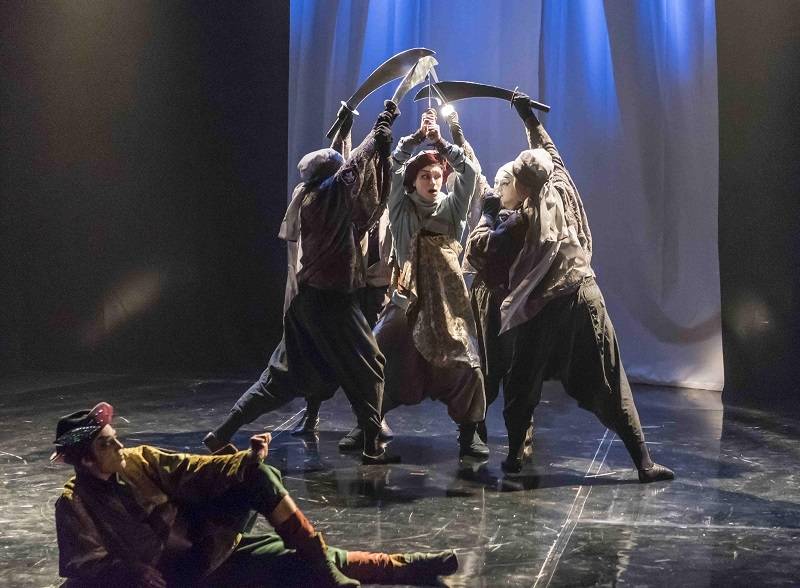
In this adaptation, one can tell from the title that Othello is no longer the lead role. Instead, the plot centered on the villainous Iago, and his reasons for enacting a revenge scheme against his commander. Jordan Coughtry, in the titular role, portrayed an anti-hero that was easy to love to hate. His facial contortions and physical balance were engrossing and admirable. While sometimes the scripted words didn’t go far enough to explain exactly why Iago was set on vengeance, the pure hatred curdled on Coughtry’s face and roiled through his posture. As he spoke, I actually found myself evaluating some of my own recent life choices in relation to the feelings he described… that Iago was getting into my head. His character poses were often precarious, reflecting his vulnerable and dangerous position, and he appeared to hold them as if it was no more difficult than standing at parade rest. And in the moment where his maniacal laugh takes over the entire stage, reveling in the chaos that has resulted from his actions, Coughtry convinced me that Iago’s heart was made of pure evil.
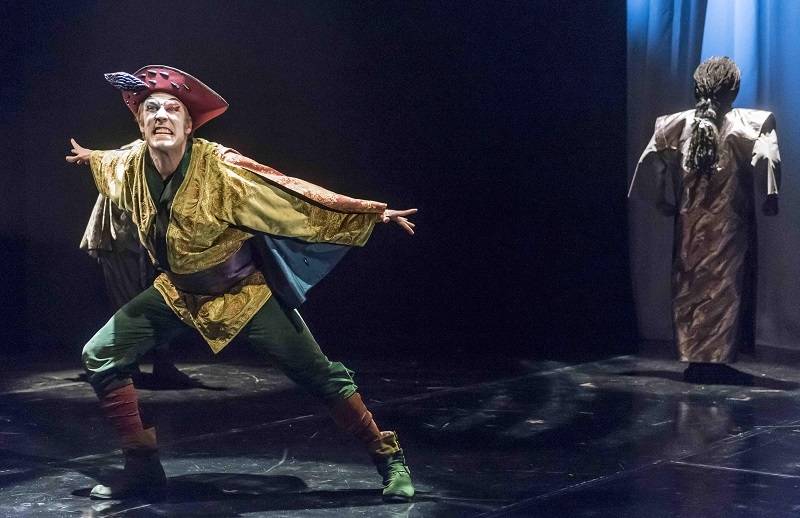
It’s one thing for me to tell you that you’ve never seen Othello in quite this manner. Another thing is that this adaptation took liberties with the basic plot, giving it some very Eastern touches and an ending you won’t remember from the Bard. And although my boyfriend said to me at intermission, “Thought I was prepared for ‘Kabuki Othello’; was not prepared for ‘Kabuki Othello’,” I know that the spectacle and experience are well worth it. And trust me, the second time is easier.
Iago’s Plot by Shozo Sato is sold out tonight and through the end of the run this Sunday, but it is possible to be put on the waiting list by going to Krannert Center’s website or by calling the ticket office at 217-333-6280. You can also try your luck by arriving at the theatre before showtime, which is 7:30 p.m. on Wednesday – Saturday, and there are matinees at 3 p.m. on Saturday and Sunday.
All images by Darrell Hoemann, courtesy of Krannert Center for the Performing Arts.








